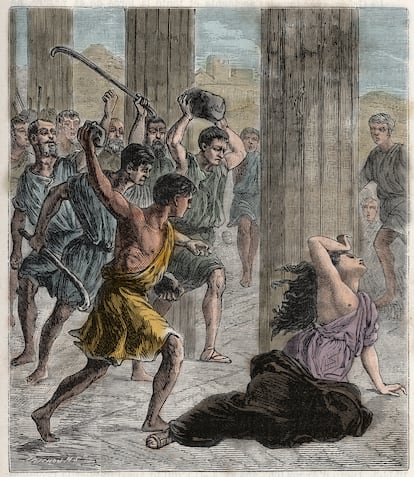Hypatia of Alexandria, the ‘pop star’ of antiquity that resists oblivion
The philosopher, mathematician and astronomer was murdered during dogmatic times. But her path of freedom lives on

Sometimes death is a symbol that survives the test of time. Hundreds of years after her assassination at the behest of Bishop Cyril, Hypatia —a Renaissance-style intellectual who defended the separation of church and state— lives on, associated with the struggle for freedom.
Voltaire, Edward Gibbon and Bertrand Russell all mentioned Hypatia in their work. Documentaries and films, such as Ágora, by Alejandro Amenábar, have been made about her life. In his hugely popular television series Cosmos, Carl Sagan described Hypatia’s death like this: “In the year 415, on her way to work she was set upon by a fanatical mob of Cyril’s parishioners. They dragged her from her chariot, tore off her clothes, and, armed with abalone shells, flayed her flesh from her bones. Her remains were burned, her works obliterated, her name forgotten.”
The years go by, but the memory of the Alexandrian woman returns again and again. She is a kind of ancient pop star who adapts to each era and survives the passage of the centuries. Currently underway is Hypatia I, a two-week mission led by Catalan scientists at the Mars Desert Research Station in Utah, where they have tested, among other things, a communications protocol with Earth. Every March 15, Hypatia Day is celebrated to promote female scientific research. The rapper Gata Cattana —who sang that “I don’t wear perfumes by Nina Ricci, I’m more into books by Silvia Federici”— named Hypatia as one of the many “daughters of Eve looking for a light.” And many more continue to remember her: at the end of 2022, the novel Hypatia, by Charles Kingsley (Legare Street Press), was republished.
Is there anyone today who, like Hypatia, is willing to die to defend their ideas? “Philosophers live on the edge of the abyss, because most people look for answers in religion, not philosophy,” essayist Costica Bradatan, author of the book Dying for Ideas: The Dangerous Lives of the Philosophers, reflects. For the Romanian author, the Alexandrian thinker had a near-religious dedication to philosophy. Her assassination —like the death of Socrates— represents the birth and consolidation of philosophy, a kind of foundation based on sacrificial acts. “They are violent deaths of a public nature, which have a certain connection with the idea of martyrs,” he said in a telephone conversation.
Bradatan describes death as “a metaphysical scandal.” He includes in his book a reflection by Pasolini, who describes death as the “editor” that gives our life meaning. If this is so, the death of Hypatia —Neoplatonic philosopher, mathematician, astronomer, and teacher, who later became a symbol of the Enlightenment, Romanticism, Protestantism, scientism and feminism— represents the struggle of reason against fanaticism, a combat for which she gave his life.
A free thinker
Hypatia knew that her open philosophical position, in the face of the growing Christian influence, could be a danger. “She was very aware of the possibility of murder, but she was also very brave. She was capable of doing whatever was necessary in the name of her principles,” says Silvia Ronchey, one of the leading experts on the Alexandrian thinker.
For this Italian researcher, Hypatia’s was not a religious death, but a political one. “She died for freedom of thought, for standing up to fundamentalism. It was her moderate position that got her assassinated.” Its instigator was Bishop Cyril. Although Catholic historiography claims Hypatia died in a street riot, Ronchey contradicts that account: “It was not a matter of pagans against Christians. Hypatia had many Christian students and was not a pagan radical,” she explains. But Hypatia defended the separation of powers between church and state, while the bishop wanted to concentrate all political power. After Hypatia’s death, intellectuals and philosophers fled in the city to Athens in search of safety.
Beyond the historical context, the confrontation between doubt and dogma, between open-mindedness and fanaticism, is an archetypal drama. It continues to be “an eternal conflict, which has not yet ended, for which many risk their lives, as we can see in Ukraine or what happens with women in Iran,” the expert says. For this reason, Hipatia is “a very contemporary figure, a kind of champion for people who suffer all kinds of injustices.”
A public threat?
Clelia Martínez Maza, professor of Ancient History at the University of Malaga, highlights Hypatia’s leading role in the intellectual and political scene of the moment, a role then forbidden to women, including those of the elite or the aristocracy. Her life and his behavior “was something very strange, observed with suspicion, as if it were a public threat,” explains Martínez, emphasizing that at that time women did not have any kind of independence. “There could be women who were more educated than others, but their fate was to take good care of the home, the children and the husband.”
Hypatia was a woman who spoke and gave her opinion in a world of men. She was also an excellent teacher, “publicly recognized despite living in a patriarchal structure, but structures that allow a certain freedom of action are one thing, and challenging them is another,” Martínez says. Hypatia was also an important intermediary figure between Jews, Christians and pagans. She embodied the spirit of consensus.
It is clear that Hypatia lived in a particularly eventful era, during the decline of the Roman Empire and its internal struggles. At the time, Alexandria was the great Mediterranean metropolis, a place of pilgrimage for philosophers and thinkers of the world. The polis resembled the Athens of the fifth century B.C., where politicians visited influential philosophers to receive advice on matters of state.
But starting from the year 400 A.C., Alexandria became an increasingly divided place. The new order ordered for pagan temples to be converted into churches or destroyed. These tensions were exemplified in the relationship between the pagan prefect Orestes and the Christian archbishop Cyril. While the former remained faithful to his paganism and cultivated a close relationship with Hypatia, Cyril wanted to erase all shadows of paganism from the city. He blamed the philosopher for the prefect’s refusal to submit to the “true” faith. It was in that volatile context that Hypatia was murdered. In dogmatic times, she was a dangerous enemy. But, paradoxically, she ended up winning: her trail of freedom is still alive.
Sign up for our weekly newsletter to get more English-language news coverage from EL PAÍS USA Edition
Tu suscripción se está usando en otro dispositivo
¿Quieres añadir otro usuario a tu suscripción?
Si continúas leyendo en este dispositivo, no se podrá leer en el otro.
FlechaTu suscripción se está usando en otro dispositivo y solo puedes acceder a EL PAÍS desde un dispositivo a la vez.
Si quieres compartir tu cuenta, cambia tu suscripción a la modalidad Premium, así podrás añadir otro usuario. Cada uno accederá con su propia cuenta de email, lo que os permitirá personalizar vuestra experiencia en EL PAÍS.
¿Tienes una suscripción de empresa? Accede aquí para contratar más cuentas.
En el caso de no saber quién está usando tu cuenta, te recomendamos cambiar tu contraseña aquí.
Si decides continuar compartiendo tu cuenta, este mensaje se mostrará en tu dispositivo y en el de la otra persona que está usando tu cuenta de forma indefinida, afectando a tu experiencia de lectura. Puedes consultar aquí los términos y condiciones de la suscripción digital.
More information
Archived In
Últimas noticias
Maduro counterattacks Trump with rhetoric and announces downing of nine drug trafficking aircraft
‘Ecce Homo’: The miraculous disaster that made a small Spanish town famous
Return to sex testing at the Olympics: IOC edges closer to banning transgender women
Trump escalates conflict with Venezuela with the start of covert operations
Most viewed
- Sinaloa Cartel war is taking its toll on Los Chapitos
- Oona Chaplin: ‘I told James Cameron that I was living in a treehouse and starting a permaculture project with a friend’
- Reinhard Genzel, Nobel laureate in physics: ‘One-minute videos will never give you the truth’
- Why the price of coffee has skyrocketed: from Brazilian plantations to specialty coffee houses
- Silver prices are going crazy: This is what’s fueling the rally











































